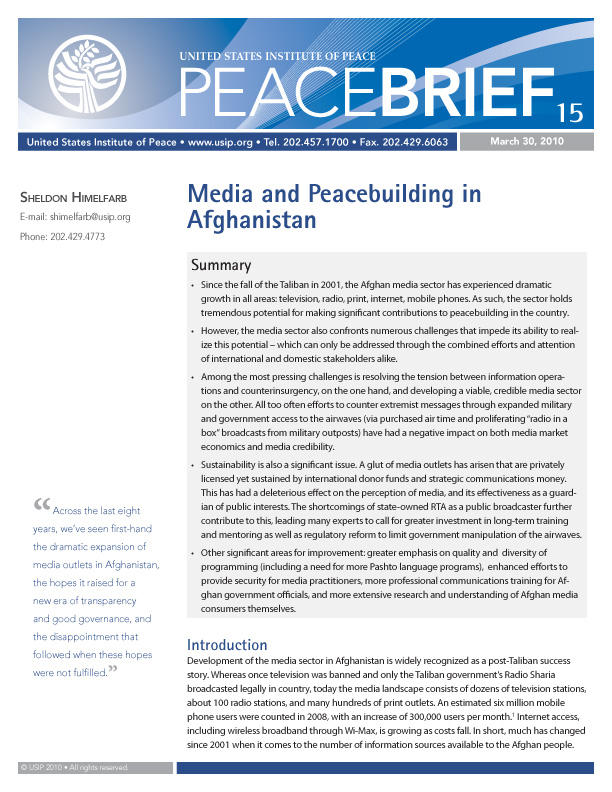Media and Peacebuilding in Afghanistan
Since the fall of the Taliban in 2001, the Afghan media sector has experienced dramatic growth in all areas: television, radio, print, internet, mobile phones. As such, the sector holds tremendous potential for making significant contributions to peacebuilding in the country.

Summary
- Since the fall of the Taliban in 2001, the Afghan media sector has experienced dramatic growth in all areas: television, radio, print, internet, mobile phones. As such, the sector holds tremendous potential for making significant contributions to peacebuilding in the country.
- However, the media sector also confronts numerous challenges that impede its ability to realize this potential - which can only be addressed through the combined efforts and attention of international and domestic stakeholders alike.
- Among the most pressing challenges is resolving the tension between information operations and counterinsurgency, on the one hand, and developing a viable, credible media sector on the other. All too often efforts to counter extremist messages through expanded military and government access to the airwaves (via purchased air time and proliferating "radio in a box" broadcasts from military outposts) have had a negative impact on both media market economics and media credibility.
- Sustainability is also a significant issue. A glut of media outlets has arisen that are privately licensed yet sustained by international donor funds and strategic communications money. This has had a deleterious effect on the perception of media, and its effectiveness as a guardian of public interests. The shortcomings of state-owned RTA as a public broadcaster further contribute to this, leading many experts to call for greater investment in long-term training and mentoring as well as regulatory reform to limit government manipulation of the airwaves.
- Other significant areas for improvement: greater emphasis on quality and diversity of programming (including a need for more Pashto language programs), enhanced efforts to provide security for media practitioners, more professional communications training for Afghan government officials, and more extensive research and understanding of Afghan media consumers themselves.
About This Brief
This report is based on a February 23, 2010 meeting of experts on media and conflict convened by the U.S. Institute of Peace’s Center of Innovation for Media, Conflict and Peacebuilding to consider opportunities and challenges for peacebuilding media in Afghanistan. The session featured presentations by distinguished experts representing the full range of media activities in country, including strategic communications, public diplomacy, radio/television/Internet/cell phone programming, training and regulation. More than 50 policymakers, producers, government officials, military officers and scholars attended the daylong meeting. Sheldon Himelfarb, executive director of USIP’s Center of Innovation for Media, moderated the session and prepared this report with the assistance of Colin Durkin.



